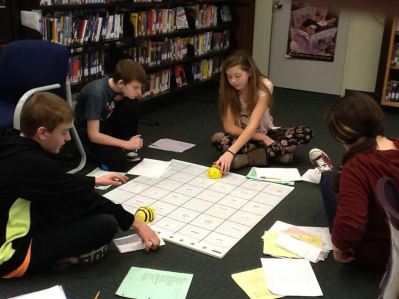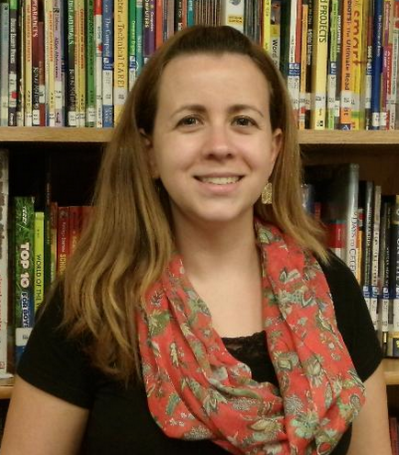Teaching for Learning: Teaching for Diverse Learning Needs
Update December 2020:
This web page is a companion to the 2016 version of the School Library Program Rubric. NYSED released an updated School Library Program Rubric in December 2020.
Student Snapshot: All students have access to the curriculum, and the library media program ensures that every student makes progress regardless of learning style or needs. test
According to Tomlinson (2014) our experiences, culture, gender, genetic codes, and neurological wiring all affect how we learn. There is no illusion that a single lesson plan will work effectively for each learner… Rather, teachers who practice differentiation accept as a given that they will need to create a variety of paths toward essential learning goals and to help students identify the paths that work best in achieving success.
Furthermore, Koechlin and Zwaan (2008) state teacher-librarians, uber responsive educators, are the magicians that make all this happen with seeming ease. They build inclusive collections, designing physical and virtual work spaces for different kinds of tasks, supporting all students in research and independent reading quests, learning and acquiring the best technology tools, and all the while dancing to the tune of individual teacher, school, district, and provincial needs.
Sources: Tomlinson, Carol Ann. The Differentiated Classroom: Responding to the Needs of All Learners. ASCD, 2014.
Koechlin, Carol and Sandi Zwaan. “Everyone Wins: Differentiation in the School Library”. Teacher Librarian, vol. 35, no. 5, 2008, pp. 8-13.
Citation for Photo: Muhlbauer, Maria. Spanish 7 Community and Neighborhood Project. 2015.
In Practice
SnapShot: A Day in the Life of a Library
Description: A blog post chronicling, in words and images, a single, hectic day in the life of a middle school library: classes, projects, teachers and students. Statistics tell only the barest slice of the story; libraries offer diverse learning experiences and resources for members of a school’s population.
Resource/Citation: Muhlbauer, Maria. “Snap-Shot NY: A Day in the Life of a Library.” Pioneer Middle School Library Happenings, 9 Feb. 2015.
Welcoming Special Education in the Library
Description: A PowerPoint presentation outlining specific library projects designed to spark the interest of middle school special education students.
Resource/Citation: Muhlbauer, Maria and Marie Proudman. “Welcoming Special Education in the Library.” Pioneer Middle School.
Strategy Guide: Assessing Student Interests and Strengths
Description: This Strategy Guide presents a number of specific methods for gaining a fuller picture of the interests of student learners as well as what students understand, know, and can demonstrate by doing.
Resource/Citation: Wilder, Phil. “Strategy Guide: Assessing Student Interests and Strengths.” ReadWriteThink.
Strategy Guide: Making the Reading Process Visible through Performance Assessment
Description: Effective differentiation begins with purposeful assessment. In this strategy guide, you’ll learn how to construct an authentic performance-based reading assessment that will give you access to students’ thinking before, during, and after reading.
Resource/Citation: Filkins, Scott. “Strategy Guide: Making the Reading Process Visible through Performance Assessment.” ReadWriteThink.
Make Learning Last: How Diverse Learners Process Their Understanding
Description: This blog post outlines the basics of differentiated instruction and provides different tools and strategies to reach diverse learners.
Resource/Citation: McCarthy, John. “Make Learning Last: How Diverse Learners Process Their Understanding.” Edutopia, 13 Jan. 2016.
iStaff: a judgement-free community
Description: This article is about how students, in grades 6-8, at Pine Grove Middle School work in roles of leadership with the school library.
*Resource/Citation: Kowalski, Sue. "iStaff: a judgement-free community." Teacher Librarian, vol. 42, no. 1, 2014, p. 23.
Teacher Uses a Variety of Strategies to Differentiate Instruction – Example 1
Description: This video shows many strategies that can be used to differentiate learning in a math class.
Resource/Citation: New York State Education Department. “Teacher Uses a Variety of Strategies to Differentiate Instruction – Example 1.” EngageNY, 20 Jan. 2016.
Teacher Uses a Variety of Strategies to Differentiate Instruction – Example 2
Description: This video demonstrates how small group work can be used to effectively differentiate learning.
Resource/Citation: New York State Education Department. “Teacher Uses a Variety of Strategies to Differentiate Instruction – Example 2.” EngageNY, 20 Jan. 2016.
Using Technology to Differentiate by Content
Description: This video outlines strategies by which technology to differentiate content delivered to students. Leila Moog, a library media specialist, discusses deploying technology such as the text to speech of library databases to individualize learner experience.
Resource/Citation: Lunk, Daniel. “Using Technology to Differentiate by Content.” LEARN NC, Feb. 2011.
In School Libraries, Differentiation through Curation
Description: This video outlines strategies by which technology to differentiate content delivered to students. Leila Moog, a library media specialist, discusses deploying technology such as the text to speech of library databases to individualize learner experience.
Resource/Citation: Morris, Rebecca J. “In School Libraries, Differentiation through Curation.” Voices in Education: Harvard Education Publishing Group, 17 Sept. 2015.
In Theory
Assistive and Adaptive Technology Resources
Description: A listing of resources and website links pertaining to assistive and adaptive resources.
*Resource/Citation: Cummings, Edward O. "Assistive and Adaptive Technology Resources." Knowledge Quest, vol. 39, no. 3, 2011, p. 70.
Differentiating for Multiple Intelligences: A Study of Students’ Understandings through the Use of Aesthetic Representations
Description: A study exploring the intersection between differentiation and Gardner’s idea of Multiple Intelligences as it pertains to educating students.
*Resource/Citation: Crim, Courtney L., Kimberley D. Kennedy, and Jenifer S. Thornton. "Differentiating for Multiple Intelligences a Study of Students' Understandings Through the Use of Aesthetic Representations." Issues in Teacher Education, 2013, vol. 22, no. 2, p. 69.
Differentiated Instructional Strategies: One Size Doesn’t Fit All
Description: This book reviews the aspects of education that can be differentiated, and details why educators should differentiate their lessons. It includes tables to organize information and a model of how to plan differentiated instruction.
*Resource/Citation: Gregory, Gayle H., and Carolyn Chapman. “One Size Doesn’t Fit All”. Differentiated Instructional Strategies: One Size Doesn't Fit All, 2013.
Libraries and Autism: We’re Connected
Description: A PowerPoint presentation discussing how libraries can best serve patrons who are on the autism spectrum.
Resource/Citation: New York State Department of Health. “Libraries and Autism: We’re Connected.” New York State Department of Health, 28 Mar. 2012.
Library Media Standards
Description: The National Board for Professional Teaching Standards (NBPTS) is an independent, nonprofit, nonpartisan, nongovernmental organization formed in 1987 to advance the quality of teaching and learning by developing professional standards for accomplished teaching. Their NBPTS Library Media Standards include Standard I: Knowledge of Learners, which says, “Accomplished library media specialists have knowledge of learning styles and of human growth and development.”
Resource/Citation: National Board for Professional Teaching Standards. “Library Media Standards”. National Board for Professional Teaching Standards, 2012.
Introducing an Information-Seeking Skill in a School Library to Students with Autism Spectrum Disorder: Using Video Modeling and Least-to-Most Prompts
Description: Noting a lack of existing literature on least-to-most prompting and video modeling in a library setting, Markey considers the experience of five children who worked with this method and suggests that it can be valuable in teaching students with autism to use library materials.
Resource/Citation: Markey, Dr. Patricia T. “Introducing an Information-Seeking Skill in a School Library to Students with Autism Spectrum Disorder: Using Video Modeling and Least-to-Most Prompts.” School Library Research: Research Journal of the American Association of School Librarians, vol. 18, 2015, pp. 1-31.
Reaching All Learners: Understanding and Leveraging Points of Intersection for School Librarians and Special Education Teachers
Description: Perrault conducted interviews with six librarians and six special education teachers in order to understand how they work with students with disabilities; they discussed adaptive technologies and inclusive education practices. Her article includes an overview of the current educational climate, a chart of points of intersection between the educators, and an analysis of the educators’ shared concerns.
Resource/Citation: Perrault, Anne Marie. "Reaching All Learners: Understanding and Leveraging Points of Intersection for School Librarians and Special Education Teachers." School Library Research: Research Journal of the American Association of School Librarians, vol. 14, 2011, pp. 1-13.
Multimodal Resources for the Education of All
Description: A listing of resources aimed to help librarians learn about disabilities and remove barriers to information.
*Resource/Citation: Wopperer, Emily. "Multimodal resources for the education of all: the following is an extensive collection of resources and starting points to assist you in meeting the learning and literacy needs of your students and teachers!" Knowledge Quest, vol. 39, no. 3, 2011, p. 36.
School Librarians of the 21st Century: Using Resources and Assistive Technologies to Support Students’ Differences and Abilities
Description: Practical tips for selecting technologies to support all learners and learning tasks.
*Resource/Citation: Copeland, Clayton A. "School librarians of the 21st century: using resources and assistive technologies to support students' differences and abilities." Knowledge Quest, vol. 39, no. 3, 2011, p. 64.
UD and UDL: Paving the Way toward Inclusion and Independence in the School Library
Description: An article discussing how principles found in Universal Design and Universal Design for Learning can be used to assist students with disabilities.
*Resource/Citation: Blue, Elfreda V. "UD and UDL: paving the way toward inclusion and independence in the school library." Knowledge Quest, vol. 39, no. 3, 2011, p. 48.
Building Strong Readers: Increase Strength and Confidence through Complex Text
Description: A discussion about the different ways complex text can be used to enhance student learning.
Resource/Citation: Fisher, Douglas, Nancy Frey, and Diane Lapp. "Building strong readers: increase strength and confidence through complex text." Literacy Today, vol. 33, no. 5, 2016, pp. 46+.
3 Ways to Plan for Diverse Learners: What Teachers Do
Description: A blog post outlining ways in which to differentiate content, process, and product.
Resource/Citation: McCarthy, John. “3 Ways to Plan for Diverse Learners: What Teachers Do.” Edutopia, 23 Jul. 2014.
Consultant
Name: Maria Muhlbauer
Email: maria.muhlbauer@gmail.com
Bio: Maria is a school librarian at Pioneer Middle School in Yorkshire, NY. She has an interest in providing unique experiences to meet the needs of all learners. Maria is the Past President of the School Librarians’ Association of Western New York and currently serves as an Adjunct Instructor for the University at Buffalo Department of Library and Information Studies.
*To access restricted database articles speak with your school librarian or public librarian.







